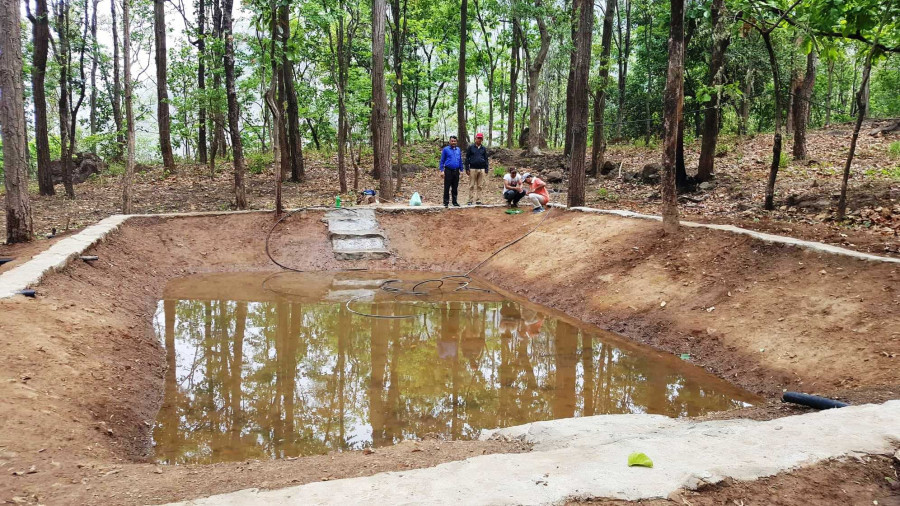Columns
Inspiring initiatives for water security
For this, we need to mobilise and empower the decision-makers of tomorrow—the students of today.
Madhukar Upadhya
The 1990s marked a significant decade in the development field, focusing on how the tangible consequences of development could reach local communities. Environmental deterioration, particularly the degradation of water sources, had already rendered economic growth sluggish. Concerns were raised that if the deterioration continued, it would hurt the poor the most. Critical reviews and evaluations of the projects and approaches to socioeconomic development, poverty reduction and environmental protection of the 1980s, as well as the then emerging apprehension regarding global environment change, led to several key global initiatives. These included the Earth Summit of 1992, the declaration of the International Decade for Natural Disaster Reduction and later the Millennium Development Goals (MDGs), which even set time-bound targets to reduce income poverty and hunger, while promoting gender equality and environmental sustainability, all of which, relate to the issue of water.
Despite heavy investments in training and the expansion of awareness on water management, development practitioners were frustrated by their inability to achieve their desired goals. One of the prerequisites for this was getting people to take ownership of these initiatives and continue to take them forward. Expressing this displeasure, an expert succinctly put it—it was like trying to push spaghetti through a keyhole when there was no one to pull it on the other side.
Early attempts
Managing water in the dry hills had already been a priority for most development agencies. Innovative approaches such as water collecting jars (ghainto) were built to catch rooftop rainwater in villages overwhelmed by water scarcity. The water collected in these ghaintos lasted for a few months. Then came plastic-lined ponds, which were easy to build and had a bigger capacity than the ghaintos. They were used to irrigate kitchen gardens, and the results were impressive. Standing water in both ghaintos and plastic-lined ponds meant a success for many. The users rejoiced, but the benefits were only short-lived and limited. These approaches only went as far as the projects that promoted them were pushed.
At about that time, the Bagmati Watershed Project, a European Union-funded project under the Ministry of Forests, of which I was a part, was promoting the building of ponds in the hills. The objective was to catch as much rainwater as possible to reduce rampant erosion and augment groundwater to improve farm productivity and promote vegetation on the hill slopes that had turned barren in the absence of soil moisture during the dry period. However, the auditors flagged the investment as beruju (unaccounted expenditures) because they found the ponds dry during their field inspection in the winter. Ironically, the water collected during the monsoon had already seeped in as designed. Beruju, in the public expenditure, earned the project a bad reputation. The project’s argument that the ponds were meant to be sinkholes, allowing rainwater to seep into the ground, did not convince the auditors.
Meanwhile, irrespective of the geographical area, the springs and small streams have progressively dried up over the last three decades. Consequently, water shortages became rampant, forcing families to move seasonally—sometimes for good—to areas with water. Moreover, no account exists of how much the depletion of water sources has affected food production. However, a silver lining seems to be emerging in addressing water security. Efforts over the past three decades and continued advocacy in promoting rainwater harvesting using ponds for augmenting groundwater have finally started to take off.
Inspiring examples
A former local school teacher from Panauti in Kavre, currently living in Australia, built 15 ponds in the dry hills of Panauti at his own expense to help restore spring sources when he visited his family last Dashain. He aims to make water available for birds and animals, as well as grass and shrubs, to reduce the risk of parched animals wandering into human settlements and damaging farms. A similar endeavour was initiated in Ghorahi, a water-poor area in the Lumbini Province, where the local municipality spent Rs18 million on building 28 water reservoirs to store rainwater.
These are only two examples that have been reported. There may be several other such initiatives, as NGOs and many environmental projects have also been promoting building ponds for rainwater harvesting. The examples from Panauti and Ghorahi illustrate that awareness about the use of ponds to restore drying water sources has increased substantially in recent years. Panauti’s case is unique because the ponds in the hills also help reduce erosion by regulating monsoon runoff!
The determination to restore local water sources demonstrated in these examples at the local level signifies a remarkable achievement, indicating that now there are people on the other side of that keyhole to pull the spaghetti. Considering the rate at which the water crisis is deepening, how rainfall patterns are becoming increasingly more erratic and the growing uncertainty of untimely extreme events due to the changing climate, such notable initiatives need to be replicated on a massive scale. This can address the already felt water crisis with a plan to maintain them continually because the ponds will soon get filled with sediment if not cared for annually.
Youth campaign
For the water harvesting techniques to be within the community’s reach, they must be affordable and doable without external support. It also requires a workforce spanning the length and breadth of the entire country, with an understanding of local water issues and a willingness to build and maintain water harvesting structures. For this, we need investment to amplify these exemplary initiatives with a massive campaign mobilising and empowering the decision-makers of tomorrow—the high school students of today.
By incorporating water harvesting lessons in the curriculum and through the practical classes on building small ponds before the monsoon and monitoring their progress periodically while they're in high school, the students will gain invaluable knowledge about rainfall, soil moisture, springs, and vegetation and enhance their understanding of how rainwater is, in fact, the source of all water sources that sustain our lives and the local environment. This approach will help create a workforce with a deep awareness of the water management needs of the country.
Unsurprisingly, irrespective of how we frame the narratives, climate change impacts water sources, and, therefore, climate adaptation actions invariably revolve around its management. Be it flood and erosion control or landslide stabilisation, addressing drought, or food security, the entry point is mostly water. The examples discussed also illustrate a great deal of awareness at the local level. All it needs now is a campaign to expedite and expand on these inspiring local initiatives.




 29.12°C Kathmandu
29.12°C Kathmandu















